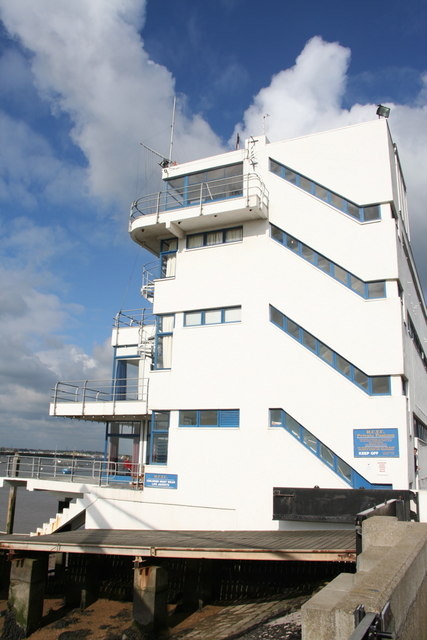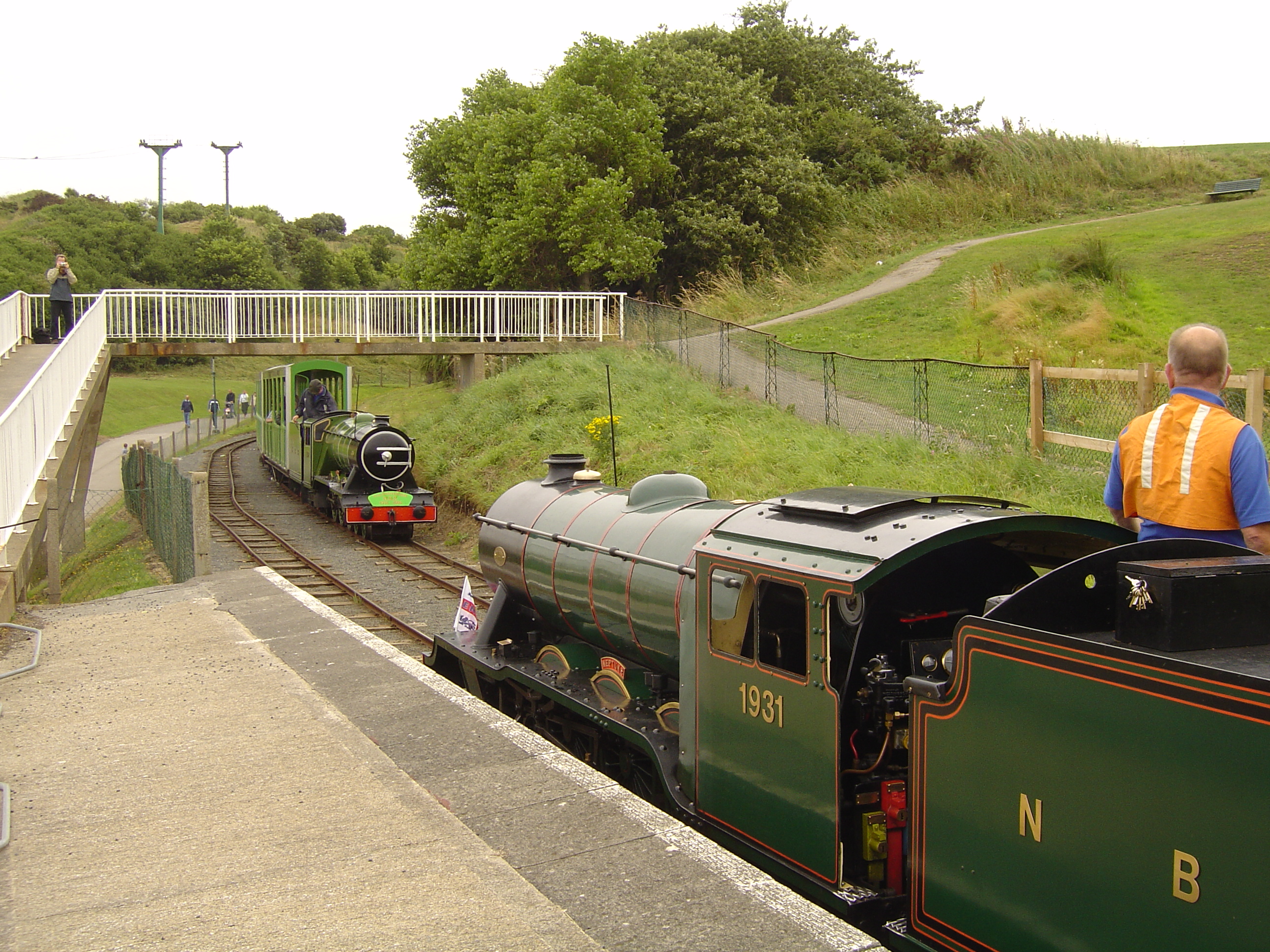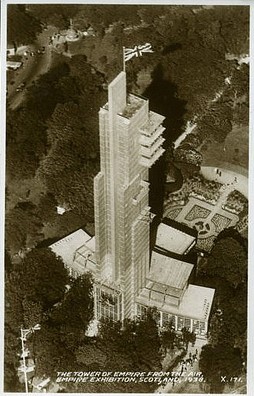|
Pleasure Beach Express
Blackpool Pleasure Beach Express is a narrow gauge railway, built in 1933 as a tourist attraction at Blackpool Pleasure Beach, Lancashire. History The main station was built in 1933, but was destroyed by fire in 1934. Redesigned by architect Joseph Emberton and rebuilt in 1935, it was replaced in 1970 by the present Victorian style building. Operation The line has two stations, Pleasure Beach Express station and Star Halt. The latter is now a request stop. The train now runs in the opposite direction to how it did originally. The animal statues and figures are all facing the wrong way, and if you look back on the tunnel mouths, there are various signs indicating the direction the train used to travel. Sometimes the railway runs backwards to give a different view of the line. Diesel locomotives The original two locomotives were supplied in 1933 and were named ''Mary Louise'' and ''Carol Jean'' after the daughters of the park owner, Leonard Thompson. The third was to be named ... [...More Info...] [...Related Items...] OR: [Wikipedia] [Google] [Baidu] |
Lancashire
Lancashire ( , ; abbreviated Lancs) is the name of a historic county, ceremonial county, and non-metropolitan county in North West England. The boundaries of these three areas differ significantly. The non-metropolitan county of Lancashire was created by the Local Government Act 1972. It is administered by Lancashire County Council, based in Preston, and twelve district councils. Although Lancaster is still considered the county town, Preston is the administrative centre of the non-metropolitan county. The ceremonial county has the same boundaries except that it also includes Blackpool and Blackburn with Darwen, which are unitary authorities. The historic county of Lancashire is larger and includes the cities of Manchester and Liverpool as well as the Furness and Cartmel peninsulas, but excludes Bowland area of the West Riding of Yorkshire transferred to the non-metropolitan county in 1974 History Before the county During Roman times the area was part of the Bri ... [...More Info...] [...Related Items...] OR: [Wikipedia] [Google] [Baidu] |
Northern England
Northern England, also known as the North of England, the North Country, or simply the North, is the northern area of England. It broadly corresponds to the former borders of Angle Northumbria, the Anglo-Scandinavian Kingdom of Jorvik, and the Celt Britonic Yr Hen Ogledd Kingdoms. The common governmental definition of the North is a grouping of three statistical regions: the North East, the North West, and Yorkshire and the Humber. These had a combined population of 14.9 million at the 2011 census, an area of and 17 cities. Northern England is culturally and economically distinct from both the Midlands and the South of England. The area's northern boundary is the border with Scotland, its western the border with Wales, and its eastern the North Sea; there are varying interpretations of where the southern border with the Midlands lies culturally; the Midlands is often also split by closeness to the North and the South. Many Industrial Revolution innovations began in N ... [...More Info...] [...Related Items...] OR: [Wikipedia] [Google] [Baidu] |
Narrow-gauge Railway
A narrow-gauge railway (narrow-gauge railroad in the US) is a railway with a track gauge narrower than standard-gauge railway, standard . Most narrow-gauge railways are between and . Since narrow-gauge railways are usually built with Minimum railway curve radius, tighter curves, smaller structure gauges, and lighter rails, they can be less costly to build, equip, and operate than standard- or broad-gauge railways (particularly in mountainous or difficult terrain). Lower-cost narrow-gauge railways are often used in mountainous terrain, where engineering savings can be substantial. Lower-cost narrow-gauge railways are often built to serve industries as well as sparsely populated communities where the traffic potential would not justify the cost of a standard- or broad-gauge line. Narrow-gauge railways have specialised use in mines and other environments where a small structure gauge necessitates a small loading gauge. In some countries, narrow gauge is the standard; Japan, Indone ... [...More Info...] [...Related Items...] OR: [Wikipedia] [Google] [Baidu] |
Blackpool Pleasure Beach
Blackpool Pleasure Beach is an amusement park situated on Blackpool's South Shore, in the county of Lancashire, North West England. It operates as a secure facility, and has introduced epayments via smartphones for admission charges, replacing wristbands and Pleasure Beach Passes, and removing the need to attend the Ticket Centre. The park was founded in 1896 by A. W. G. Bean and his partner John Outhwaite and has been family owned and operated since its inception. The current managing director is Bean's great-granddaughter Amanda Thompson. The park is host to many records, including the largest collection of wooden roller coasters of any park in the United Kingdom with four: the Big Dipper, Blue Flyer, Grand National and Nickelodeon Streak. Many of the roller coasters in the park are record-breaking attractions. When it opened in 1994, The Big One was the tallest roller coaster in the world. It was also the steepest, with an incline angle of 65° and the second fastest w ... [...More Info...] [...Related Items...] OR: [Wikipedia] [Google] [Baidu] |
Joseph Emberton
Joseph Emberton (23 December 1889 – 20 November 1956) was an English architect of the early modernist period. He was born 23 December 1889 in Audley, Staffordshire and was educated at the Royal College of Art. He first worked for the London architects Trehearne and Norman between 1913 and 1914, before serving as a gunner in the Honourable Artillery Company during the First World War. In 1923 he designed Olympia National, then known as the New Hall. This sat alongside Olympia Grand at the Kensington event venue. 1932 saw the construction of his second addition to Olympia – Olympia Central (initially named the Empire Hall). These halls, along with other event spaces, all make up one of London's largest event venues – Olympia London. His 1931 design of the Royal Corinthian Yacht Club at Burnham-on-Crouch represented Britain at the influential International Exhibition of Modern Architecture held at Museum of Modern Art in New York City in 1932. He went on to design the Sim ... [...More Info...] [...Related Items...] OR: [Wikipedia] [Google] [Baidu] |
Hudswell Clarke
Hudswell, Clarke and Company Limited was an engineering and locomotive building company in Jack Lane, Hunslet, Leeds, West Yorkshire, England. History The company was founded as Hudswell and Clarke in 1860. In 1870 the name was changed to Hudswell, Clarke and Rodgers. There was another change in 1881 to Hudswell, Clarke and Company. The firm became a limited company in 1899. In 1862, soon after the company had been formed, they were given the initial design work on William Hamond Bartholomew's compartment boats for the Aire and Calder Navigation. The choice of the company may have been influenced by the fact that Bartholomew, the chief engineer for the Navigation, and William Clayton, one of the founders of Hudswell and Clarke, both lived on Spencer Place in Leeds. They produced at least one of the prototype Tom Pudding compartments, but did not get the main contract for their production once the design work had been done. As steam locomotive builders, like many of the sm ... [...More Info...] [...Related Items...] OR: [Wikipedia] [Google] [Baidu] |
Scarborough North Bay Railway
Scarborough North Bay Railway (SNBR) is a ridable miniature railway (also known as a minimum-gauge railway) in Scarborough, North Yorkshire, England. It was built in 1931, to the gauge of , and runs for approximately between Peasholm Park and Scalby Mills in the North Bay area of the town. The railway attracted approximately 200,000 visitors in the 2014–2015 season, and remains popular with tourists. History Various patches of land were bought up by the Scarborough Corporation during the late 1920s and early 1930s. Originally, the railway was set further back, but its terminus at Peasholm Park was amended so that it could be seen by pedestrian traffic going to North Bay. The opening ceremony took place at 2 p.m. on Saturday 23 May 1931. The locomotive, ''Neptune'', was officially handed over by the Chairman of the North Side Development Committee, Alderman Whitehead, to the Mayor of Scarborough, Alderman J. W. Butler, for the Entertainments Department. Alderman Whit ... [...More Info...] [...Related Items...] OR: [Wikipedia] [Google] [Baidu] |
4-6-2
Under the Whyte notation for the classification of steam locomotives, represents the wheel arrangement of four leading wheels on two axles, six powered and coupled driving wheels on three axles and two trailing wheels on one axle. The locomotive became almost globally known as a Pacific type. Overview The introduction of the design in 1901 has been described as "a veritable milestone in locomotive progress". On many railways worldwide, Pacific steam locomotives provided the motive power for express passenger trains throughout much of the early to mid-20th century, before either being superseded by larger types in the late 1940s and 1950s, or replaced by electric locomotive, electric or diesel locomotive, diesel-electric locomotives during the 1950s and 1960s. Nevertheless, new Pacific designs continued to be built until the mid-1950s. The type is generally considered to be an enlargement of the 4-4-2 (locomotive), Atlantic type, although its NZR Q class (1901), prototype had ... [...More Info...] [...Related Items...] OR: [Wikipedia] [Google] [Baidu] |
Empire Exhibition, Scotland 1938
Empire Exhibition, Scotland 1938 was an international exposition held at Bellahouston Park in Glasgow, from May to December 1938. The Exhibition offered a chance to showcase and boost the economy of Scotland, and celebrate Empire trade and developments, recovering from the depression of the 1930s. It also marked fifty years since Glasgow's first great exhibition, the International Exhibition (1888) held at Kelvingrove Park. It was the second British Empire Exhibition, the first having been held at Wembley Park, London in 1924 and 1925. Its function was similar to the first National Exhibition in Paris in 1798, and to the first International Exhibition, the Great Exhibition in London in 1851 attended by 6 million visitors. It was declared open by King George VI and Queen Mary on 3 May 1938 at the Opening Ceremony in Ibrox Stadium, attended by 146,000 people. In addition to the Royal Patrons and the Honorary Presidents representing governments and institutions here ... [...More Info...] [...Related Items...] OR: [Wikipedia] [Google] [Baidu] |
21 In Gauge Railways In England
1 (one, unit, unity) is a number representing a single or the only entity. 1 is also a numerical digit and represents a single unit of counting or measurement. For example, a line segment of ''unit length'' is a line segment of length 1. In conventions of sign where zero is considered neither positive nor negative, 1 is the first and smallest positive integer. It is also sometimes considered the first of the infinite sequence of natural numbers, followed by 2, although by other definitions 1 is the second natural number, following 0. The fundamental mathematical property of 1 is to be a multiplicative identity, meaning that any number multiplied by 1 equals the same number. Most if not all properties of 1 can be deduced from this. In advanced mathematics, a multiplicative identity is often denoted 1, even if it is not a number. 1 is by convention not considered a prime number; this was not universally accepted until the mid-20th century. Additionally, 1 is th ... [...More Info...] [...Related Items...] OR: [Wikipedia] [Google] [Baidu] |




.jpg)

